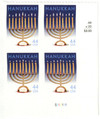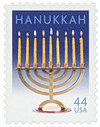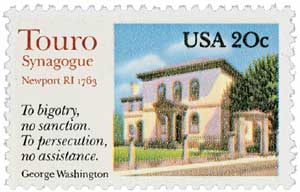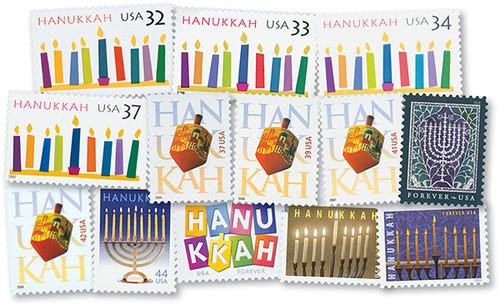
# 4433 - 2009 44c Hanukkah
Hanukkah
Issue Date: October 9, 2009
City: New York, NY
Hanukkah is a Jewish festival that celebrates the rededication of the Temple of Jerusalem and a miracle that occurred there. In 165 B.C., Judah Maccabee led a revolt against Palestine’s ruler, Syrian King Antiochus IV, who forbade the practice of Judaism. The king also defiled the Temple of Jerusalem by using it to worship the pagan god Zeus. Maccabee defeated Antiochus and took control of Jerusalem.
To rededicate the Temple, oil was needed for a burning light to symbolize the strength of God. Legend states that only enough oil to last one day could be found, but miraculously, the oil burned for eight days. Since that time, Hanukkah is celebrated each year for eight days, beginning on the 25th day of the month of Kislev in the Gregorian calendar (usually December). During the festive celebration, families gather together to light eight candles in a menorah (candelabrum shown on cachet) just after sunset. A ninth candle (shammes) on the menorah is used to light the candles, one more each day until all are lit.
Other traditions include singing and eating fried foods in memory of the miracle of the oil. Children often receive gifts or money and chocolate coins (gelt) that may be used to bet on the game of dreidel.
Dedication Of Touro Synagogue
In the 1620s, Jewish settlers of Spanish and Portuguese origin fled their homes in Amsterdam and London in search of religious freedom. Over the years they traveled from Brazil to the Caribbean, particularly Barbados. Then in the spring of 1658, fifteen Spanish/Portuguese Jewish families arrived in Newport, Rhode Island. They believed they would be able to practice their faith under the law of Governor Roger Williams. Williams established the Colony of Rhode Island and Providence Plantations on the basis of freedom of religion and conscience. This congregation was known Nephuse Israel (Scattered of Israel).
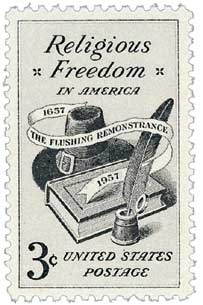
For 100 years, this small congregation worshiped in private homes. Then in 1758, the congregation had grown in size so as to require a synagogue. Cantor Isaac Touro led the campaign to establish a synagogue. After soliciting funds from other congregations, as far away as London, Jamaica, and Surinam, land was purchased in 1759. Construction began soon after, with local philanthropist Aaron Lopez laying the corner stone. The renowned architect Peter Harrison, who may have donated his work, designed the synagogue. Inside, the synagogue had 12 Ionic columns, representing the 12 tribes of ancient Israel, each carved from a single tree. The building was also built to face east toward Jerusalem.
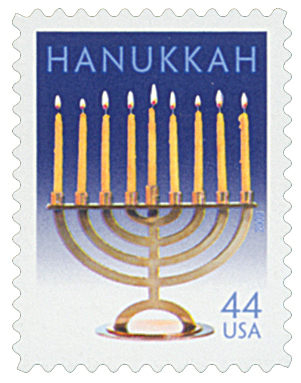
Once completed, the synagogue was dedicated on December 2, 1763, during that year’s Chanukah festival celebrations. Many people outside of the congregation came to celebrate the synagogue’s opening. These included clergy and dignitaries from around the colony, including Congregationalist Minister Ezra Stiles (future president of Yale University).
During the American Revolution, many of the town’s Jewish residents fled the city when the British occupied it. Isaac Touro remained to keep watch over the synagogue. The British used it as a hospital and assembly hall. Although they needed wood for burning during the winter, the synagogue’s importance as a hospital spared it from being destroyed. After the British left, the Jewish families began to return.
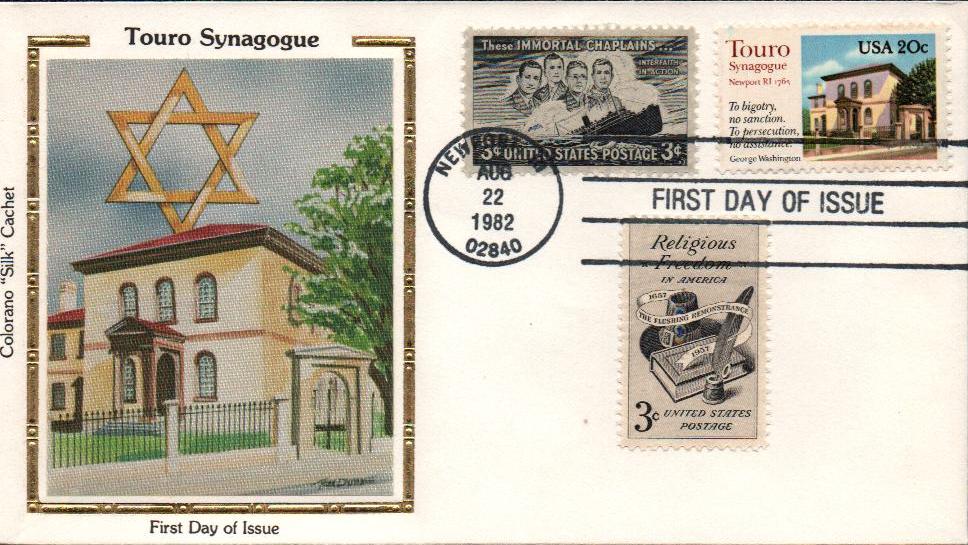
In 1790, the congregation’s president, Mendes Seixas, sent President George Washington a letter expressing his support for his administration. He also shared his ideas about the importance of religious liberties and the separation of church and state in the new nation. President Washington responded in part,
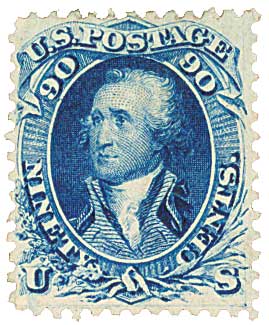
“The Government of the United States … gives to bigotry no sanction, to persecution no assistance. … May the children of the Stock of Abraham, who dwell in this land, continue to merit and enjoy the good will of the other Inhabitants; while every one shall sit in safety under his own vine and fig tree, and there shall be none to make him afraid. May the father of all mercies scatter light and not darkness in our paths, and make us all in our several vocations useful here, and in his own due time and way everlastingly happy.” In the years since, the synagogue has held an annual reading of Washington’s letter. Read the full text of Washington’s letter here.
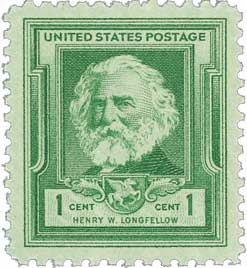
Over the years, the congregation dispersed and the synagogue closed. In July 1852, famed poet Henry Wadsworth Longfellow visited the synagogue and its cemetery. He was so moved by the experience, he penned a popular poem, “The Jewish Cemetery at Newport,” which you can read here.
Two years later, Judah Touro, son of the synagogue’s namesake, left a bequest for its restoration. By the 1880s, new Jewish families arrived from Europe and reopened the synagogue.
In 1946, the Touro Synagogue was made a National Historic Site. Today, it’s the oldest standing synagogue in the U.S.
Click here for a short video about Touro Synagogue.
Hanukkah
Issue Date: October 9, 2009
City: New York, NY
Hanukkah is a Jewish festival that celebrates the rededication of the Temple of Jerusalem and a miracle that occurred there. In 165 B.C., Judah Maccabee led a revolt against Palestine’s ruler, Syrian King Antiochus IV, who forbade the practice of Judaism. The king also defiled the Temple of Jerusalem by using it to worship the pagan god Zeus. Maccabee defeated Antiochus and took control of Jerusalem.
To rededicate the Temple, oil was needed for a burning light to symbolize the strength of God. Legend states that only enough oil to last one day could be found, but miraculously, the oil burned for eight days. Since that time, Hanukkah is celebrated each year for eight days, beginning on the 25th day of the month of Kislev in the Gregorian calendar (usually December). During the festive celebration, families gather together to light eight candles in a menorah (candelabrum shown on cachet) just after sunset. A ninth candle (shammes) on the menorah is used to light the candles, one more each day until all are lit.
Other traditions include singing and eating fried foods in memory of the miracle of the oil. Children often receive gifts or money and chocolate coins (gelt) that may be used to bet on the game of dreidel.
Dedication Of Touro Synagogue
In the 1620s, Jewish settlers of Spanish and Portuguese origin fled their homes in Amsterdam and London in search of religious freedom. Over the years they traveled from Brazil to the Caribbean, particularly Barbados. Then in the spring of 1658, fifteen Spanish/Portuguese Jewish families arrived in Newport, Rhode Island. They believed they would be able to practice their faith under the law of Governor Roger Williams. Williams established the Colony of Rhode Island and Providence Plantations on the basis of freedom of religion and conscience. This congregation was known Nephuse Israel (Scattered of Israel).

For 100 years, this small congregation worshiped in private homes. Then in 1758, the congregation had grown in size so as to require a synagogue. Cantor Isaac Touro led the campaign to establish a synagogue. After soliciting funds from other congregations, as far away as London, Jamaica, and Surinam, land was purchased in 1759. Construction began soon after, with local philanthropist Aaron Lopez laying the corner stone. The renowned architect Peter Harrison, who may have donated his work, designed the synagogue. Inside, the synagogue had 12 Ionic columns, representing the 12 tribes of ancient Israel, each carved from a single tree. The building was also built to face east toward Jerusalem.

Once completed, the synagogue was dedicated on December 2, 1763, during that year’s Chanukah festival celebrations. Many people outside of the congregation came to celebrate the synagogue’s opening. These included clergy and dignitaries from around the colony, including Congregationalist Minister Ezra Stiles (future president of Yale University).
During the American Revolution, many of the town’s Jewish residents fled the city when the British occupied it. Isaac Touro remained to keep watch over the synagogue. The British used it as a hospital and assembly hall. Although they needed wood for burning during the winter, the synagogue’s importance as a hospital spared it from being destroyed. After the British left, the Jewish families began to return.

In 1790, the congregation’s president, Mendes Seixas, sent President George Washington a letter expressing his support for his administration. He also shared his ideas about the importance of religious liberties and the separation of church and state in the new nation. President Washington responded in part,

“The Government of the United States … gives to bigotry no sanction, to persecution no assistance. … May the children of the Stock of Abraham, who dwell in this land, continue to merit and enjoy the good will of the other Inhabitants; while every one shall sit in safety under his own vine and fig tree, and there shall be none to make him afraid. May the father of all mercies scatter light and not darkness in our paths, and make us all in our several vocations useful here, and in his own due time and way everlastingly happy.” In the years since, the synagogue has held an annual reading of Washington’s letter. Read the full text of Washington’s letter here.

Over the years, the congregation dispersed and the synagogue closed. In July 1852, famed poet Henry Wadsworth Longfellow visited the synagogue and its cemetery. He was so moved by the experience, he penned a popular poem, “The Jewish Cemetery at Newport,” which you can read here.
Two years later, Judah Touro, son of the synagogue’s namesake, left a bequest for its restoration. By the 1880s, new Jewish families arrived from Europe and reopened the synagogue.
In 1946, the Touro Synagogue was made a National Historic Site. Today, it’s the oldest standing synagogue in the U.S.
Click here for a short video about Touro Synagogue.





